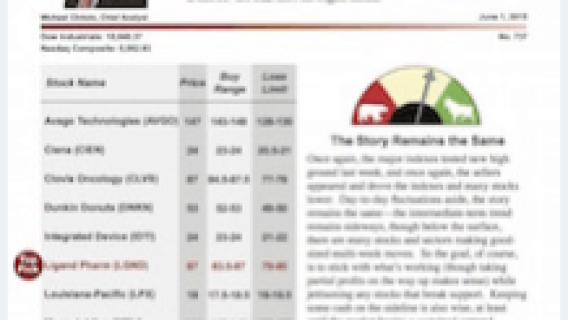Cabot Top Ten Trader and the Stock Guru Behind It
Every once in a while, I like to have a talk with one of Cabot’s editors about one of their publications. It’s interesting (and useful) to know what’s on their minds and how they see their advisories being used by subscribers.
Today, I’m talking with Mike Cintolo about Cabot Top Ten Trader, which comes out every Monday after the market closes. We’ve been publishing the newsletter since 2002, and this week we’re celebrating its 16th anniversary.
Mike Cintolo is a man of relatively few obsessions, but when he gets interested in something, he jumps in with both feet and a backpack. I like to claim, modestly, that I was responsible for setting his feet on the path to a deep and knowledgeable appreciation of bourbon whiskey. But in two areas, his enthusiasm, scholarship and expertise leave me far behind.
[text_ad]
I’m not going to write about Mike’s love of the NFL in general and the New England Patriots in particular. I’ll just note that Mike’s mood has lifted slightly now that NFL training camp is on the horizon, but that he won’t be a fully engaged person until The Season starts.
What I am going to write about is Mike’s extraordinary dedication to growth stock investing, something that he apparently learned at his father’s knee, but has made both his vocation and his avocation.
He reads books on growth investing, then reads them again, searching for just one idea or observation that will give him a bit of leverage in his trading and help him to explain growth investing to his subscribers.
Every weekend, 50 weeks of the year, Mike will scan the entire universe of stocks that trade on U.S. stock exchanges, looking for the 10 stocks at the very top of the growth world. They trade enough volume (above $20 million a day) and their prices are usually above 12, which makes them attractive targets for institutional investors. And they have strong stories with the potential for huge growth.
The summary of those 10 stocks goes out to subscribers by email every Monday in Cabot Top Ten Trader.
I asked Mike a few questions about Top Ten (which is what we call it in-house). Here’s what he had to say.
Paul: What’s the single most important thing a stock has to have to qualify for inclusion in Top Ten?
Mike: I’m looking for a stock that combines strong price performance with the potential for continued sponsorship by institutional investors. Sometimes that potential comes from being a first mover in a developing field and sometimes it’s a surprisingly strong quarterly report that catches investors’ attention. But a great chart that shows rising interest has to be there.
Our OptiMo system (stands for optimum momentum) looks for stocks with a unique mix of shorter-term relative strength (to tell you buyers are active now) and longer-term relative strength (to tell you the overall path of least resistance is up) and then takes out the illiquid stocks. I’m usually left with a few dozen names out of more than 10,000 in the market—all of which are under intense accumulation.
We do a lot more than just drop names in subscribers’ lap, though. We tell everyone why the stock is strong, and what its prospects are for the future—if we think the stock is more of a short-term trade, we’ll say it. And if we think it could be a big winner over time, we’ll say that, too. We provide suggested buy ranges and loss limits, and provide follow-up as well.
Paul: Most growth investors don’t buy ten stocks every week, so how do subscribers use all that information?
Mike: A write-up in Top Ten will tell people why the stock is strong, analyze its chart, summarize its fundamentals and give a suggested buy range and loss limit. But investors need to do their own due diligence on stocks before they buy them. Top Ten will present a great slate of candidates every week, but it’s up to each person to make the final selections.
Paul: There’s an Editor’s Choice every week. How do you make that selection?
Mike: That’s an informed guess. I’m following the markets for eight hours a day, five days a week, and I use everything I know about how markets and specific sectors are performing and the stocks themselves to pick the setup that looks best to me.
Paul: Top Ten has a great record of finding stocks early in their advances, but what’s your batting average in picking winners?
Mike: Growth stocks are volatile, there’s no doubt about it. The key to growth investing isn’t being right every time. Nobody can do that. The key is making good money when you’re right and cutting losses short when a buy doesn’t work out. We follow every stock that falls into our buy range on page 12 of every issue.
And we report every Friday in our Movers and Shakers email on which stocks are performing well and which ones should be cut loose. Subscribers still have to do the work of buying and selling, but we take responsibility for following every pick we make.
Paul: Who’s the ideal subscriber to Cabot Top Ten Trader?
Mike: The ideal subscriber is an active investor who’s looking for new ideas or wants to keep up with the strongest stocks the markets have to offer. Top Ten will give that kind of investor a load of useful information they won’t get anywhere else. Our proprietary screens are constantly keeping subscribers updated on what’s leading the market. It basically tells you where, in the ocean of stocks, to drop your anchor if you want to catch the biggest fish.
Paul: What kind of environments does Top Ten thrive in?
Mike: As you know, Paul, a roaring bull market is best—the publication highlights a ton of big winners multiple times, giving subscribers ample opportunity to grab them.
But what’s really great about Top Ten is that there are no biases; whatever is working will show up in Top Ten, whether it’s defensive, income-oriented stocks (we actually had a few REITs show up early this year), tech stocks, energy stocks … you name it, our screens will find it.
In fact, I remember joking with Tim Lutts in early 2004 about how a bunch of refiners were showing up in Top Ten—Valero, Tesoro and the like. We were so skeptical about whether they were going to work we were basically mocking them; remember, this was after 15 years of tech stocks leading the way higher in the market. Thankfully we didn’t listen to our own biases—those and many other energy names like Southwestern Energy and Ultra Petroleum turned into huge winners for Top Ten subscribers!
Paul: You mentioned market timing—does Top Ten have a market timing system, and if so, how does it work?
Mike: We do have one, and it’s summed up on the first page of every issue via a simple red-yellow-green barometer. And the system is really derived from the same sort of trend-following measures we use in Cabot Growth Investor and your Cabot Emerging Markets Investor (now Cabot Global Stocks Explorer) Paul.
I would say the main difference from those publications is that I put more emphasis on the action of individual Top Ten stocks; every week I go through a few dozen Top Ten names. If I see a bunch of sour action, I might lean cautious no matter what the major indexes are doing.
Conversely, if I see a bunch of constructive set-ups, I might do the opposite. Interestingly, that’s what I’ve seen of late—many Top Ten stocks have held their own in recent weeks while the market was yanked down by interest rate fears. That’s a good sign for the market as a whole, and for those stocks.
To learn more about Cabot Top Ten Trader, click here.
[author_ad]

